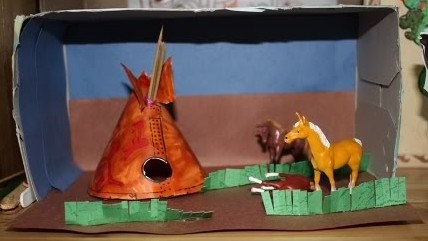
Although I really, really like the idea that dioramas are the invention and sole provenance of elementary school teachers, I could probably do some kind of obsessive genealogy of the diorama throughout history. I could trace this mutating medium from eerie taxidermies to discredited anthropologies behind museum glass; from Persian miniature painting to ancient narrative friezes; from adults goofing off in tableaux vivant to children getting serious with flimsy trompe l’oeil toy theater; architectural table models aspiring to full-scale reality, and boxed-in modernist fantasies intended to trouble it out of existence; Terra Cotta Warriors at attention in the dirt, and Mr. Rogers’ Land of Make-Believe one trolley-stop away; North Korean communist spectacle that shrinks the human and Vegas weddings that enlarge love with immersive kitsch; from puppet shows to panoramas to peep shows; shadow boxes and ships in bottles; cult shrines and curiosity cabinets; idol niches and Christ creches; Victorian dollhouses and Castle Greyskull playsets. And I could maybe explain why Piehole’s found this form useful in examining Transcendental utopias and New England winters. Sure, I could do that.

When something small and wayward enters the scene and causes a stalk of broccoli to become, for an instant, a stately oak tree, it’s a diorama.
When you find yourself suddenly looking at the town you live in from a vantage point that makes you ask, “wait, that is where I actually live? My life takes place inside of that? I’m an ant in that ant colony?”— goddamnit, you’ve got yourself a diorama there.
When you go to a neighborhood or block you haven’t been to for a while, but used to frequent, and notice the changes, as if who and what used to be there (and seemed to belong there) was simply plucked up by a giant hand and replaced with something you could swear you’ve seen an identical version of before, like it was punched out of a mold somewhere…DIORAMA.
You lay your head on your desk, your computer keyboard becomes the Berlin Holocaust memorial, the coffee mug some kind of giant water tank miles away, the cubicle wall a grey sky. Diorama.
The dashboard GPS shows you moving through a world without a past or future, but a highly detailed infrastructure nonetheless. Diorama.
Unexpected, total eruption of a still news image into your apartment at 3:42PM. Diorama.
Recognize your friend, in all his complexity, 2 blocks away by just the way he walks. Diorama.
As the train dips down off the bridge and heads underground, look—quick!—at the rising slice of street level action, at the burst of stuff: firmly rooted nouns of buildings, dynamic verbs of people, that unexplained statement, neither true nor false, that tiny fragment of the giant run-on sentence of the place you live that this rapidly sinking frame happens to be delivering to you at this moment. Imagine that this 10-second, infinitely deep image is all you know of the world—no, imagine it is the whole world. Hold it in your mind and try to go in there and look around. Diorama.

We’re not just seeing something, We’re seeing something through something else; a special kind of seeing that is made possible by a framing, a bounding, a boxing, a stooping down, a peering over, a forced perspective, a juxtaposition, an overlay, overhang, pinhole, keyhole, alcove, bevel, sill, edge, protrusion, crosshair, lattice, size reference, accident, incident, the opening of window, the closing of a prison door. See more by seeing less. Or less by seeing more.
So the next time you see the fateful shooting scene from Old Yeller, represented with a repainted GI Joe, day-glo Play-Doh™ in a shape that is more iguana than Black Mouth Cur, crayons on cardboard, fake grass from takeout sushi, and some fluffy white cotton balls, deaf to the imminent blast in the scribbled blue of brilliant sky—all this frozen for eternity in a Nike™ box—don’t forget that you’re seeing the perfected modern form of a metaphor for that thing we can do, where our brains take the vast messes of time and space and finds new things to see them through, till they mean something different. Being good at that can make us good people. Always be making dioramas, throwing them away, making new ones.
-Jeff


 RSS Feed
RSS Feed